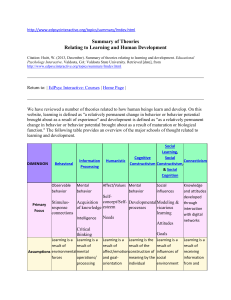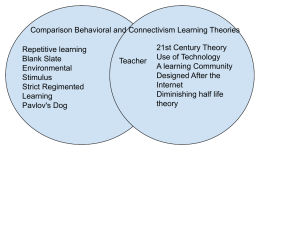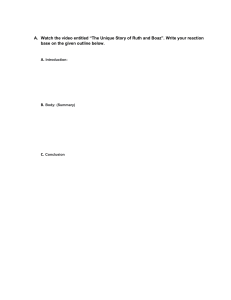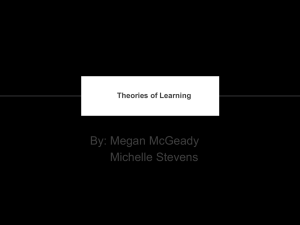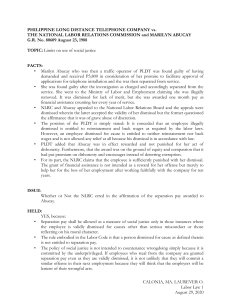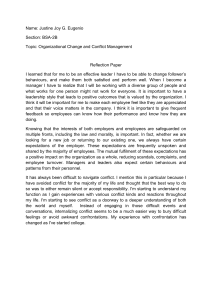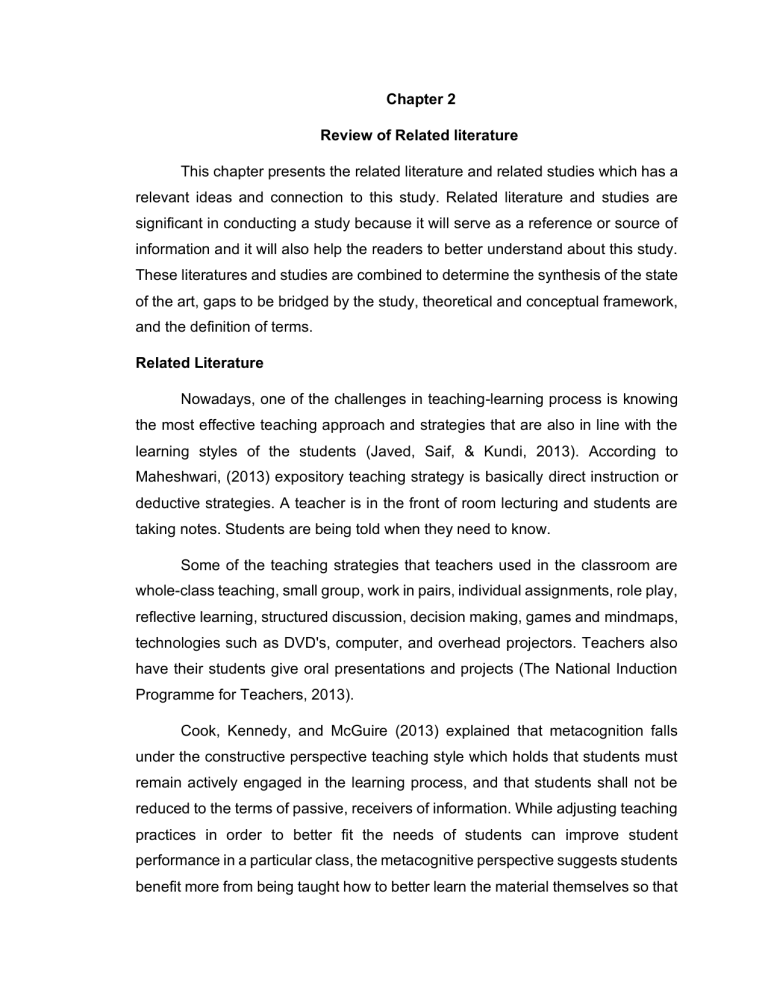
Chapter 2 Review of Related literature This chapter presents the related literature and related studies which has a relevant ideas and connection to this study. Related literature and studies are significant in conducting a study because it will serve as a reference or source of information and it will also help the readers to better understand about this study. These literatures and studies are combined to determine the synthesis of the state of the art, gaps to be bridged by the study, theoretical and conceptual framework, and the definition of terms. Related Literature Nowadays, one of the challenges in teaching-learning process is knowing the most effective teaching approach and strategies that are also in line with the learning styles of the students (Javed, Saif, & Kundi, 2013). According to Maheshwari, (2013) expository teaching strategy is basically direct instruction or deductive strategies. A teacher is in the front of room lecturing and students are taking notes. Students are being told when they need to know. Some of the teaching strategies that teachers used in the classroom are whole-class teaching, small group, work in pairs, individual assignments, role play, reflective learning, structured discussion, decision making, games and mindmaps, technologies such as DVD's, computer, and overhead projectors. Teachers also have their students give oral presentations and projects (The National Induction Programme for Teachers, 2013). Cook, Kennedy, and McGuire (2013) explained that metacognition falls under the constructive perspective teaching style which holds that students must remain actively engaged in the learning process, and that students shall not be reduced to the terms of passive, receivers of information. While adjusting teaching practices in order to better fit the needs of students can improve student performance in a particular class, the metacognitive perspective suggests students benefit more from being taught how to better learn the material themselves so that they can apply these strategies to every class. The metacognitive perspective dictates that students should be given the tools that they need in order to learn and develop meaningful skills such as retaining information, applying information, and creatively solving problems. According to Hamzeh (2014), there are several teaching strategies that can be used by teachers to improve the academic performance of the students. Those teaching strategies are accounted for in different time periods and applied inside the classroom. The most common one is lecture type. It is an instructional method where the teacher who possesses the knowledge on a given topic delivers all relevant information to students verbally. The person presenting the lecture was called a reader because the information in the book was read to students who would then copy the information all down (Goffe & Kauper, 2014). Teaching is a process delivery of knowledge and experience from teacher to the students. According to Lesiak (2015) teaching is the didactic process in which both the teacher and student participate, and its main goal is to promote and support learning. Activity of teaching did not separate with learning process. It means that, if the teacher teach students about a topic, the students must be learned about it. Teaching process do by teacher, a teacher should be help students to learn about the knowledge. It is not only learn about knowledge, but also students behaviour and attitude to prepare the students for future life. In the University of the Philippine System they have the online evaluation of teachers in which the recommendations for the teaching medium from the students happened and are suggested by their bona fide students that is highly honoured by their faculty (Computerized Registration System Evaluation, 2015). Cohen in Nawaz et al (2015) also stated that Cooperative Learning is a teaching strategy combines different social and academic experience into the classroom activities. They get benefit from one another resources, experience, skills, information, and monitoring one another’s activities in cooperative learning. In order to make this method to be effective, students must learn to respect one another differences, to support one another in learning process, and to communicate effectively. Teachers need to understand the process of individual learning. In the learning process, individuals are interacting with the environment, i.e., uniquely processing the information and requiring a unique environment for learning. Thus, addressing the challenge in facilitating learning conditions while organizing such interactions should be taken into consideration to help individuals to optimize their learning (Sighn, 2017). Related Studies Albakri et al (2012) stated in a study entitled "Experienced Teachers Pedagogical Strategies in Content-based Instruction Contexts" that teachers differ in their selection and use of instructional strategies. Moreover, teachers of different backgrounds, experience, and subject matter deal differently with strategies. The strategies that they use in the classroom reflect their beliefs, assumptions and understanding of the teaching of an integrated syllabus. Thomson (2012) carried out a study entitled “Language Teaching Strategies and Techniques Used to Support Students Learning in a Language other than Their Mother Tongue”. He stated that teachers used different teaching strategies in the classroom which are: vocabulary checks, eliciting, modelling of target language, think aloud, modelling of activities, student thinking time, re-casts, error correction, incorporating small group and pair work in lessons, and elaborated input. Use of these strategies depends on the class level. To achieve the objectives of the research the researcher used lesson observations, teacher interviews, coordinator interviews and field notes to collect information. The findings showed that strategies are important because they increase the interaction between the teachers and their students. Teachers should use the appropriate strategies for the student's level. The researcher recommended teachers to develop their understanding for teaching strategies and they should use different strategies. According to the study cited in Nabors et. al. (2012), Paulson & Faust, (1998), active learning is not just a transmission of information, but focuses on developing learner's skills and increasing students' attention in the classroom. The techniques that teachers use promote creative thinking, students involvement and develop problem solving skills. Some of the active strategies are discussion, group work, lecture, case studies, concept analysis, games, and concept mapping. Lecture strategy can also be considered non-traditional if the teachers use active strategies with them such as asking questions throughout the lecture. Hamiloðlu and Temiz (2012) stated in a study entitled "The Impact of Teachers’ Questions on Student Learning" that teachers’ questions are very important strategy in the classroom for checking students' understanding and obtaining information about the learning process. The researchers used qualitative and quantitative techniques. The results of the research showed that effective questioning by the teachers focus on motivating students to learn, arouse their curiosity, stimulate their imagination, and focus the students’ attention on understanding the content of the lesson. Teachers should therefore use questions that activate students' minds and plan the lesson carefully. The researchers recommended teachers to use different types of questioning. According to the study of Donald C. Orlich, et al (2012) entitled “Teaching Strategies: A Guide to Effective Instruction”, now in its tenth edition, is known for its practical, applied help with commonly used classroom teaching strategies and tactics. Ideal for anyone studying education or involved in a site-based teacher education program, the book focuses on topics such as lesson planning, questioning, and small-group and cooperative-learning strategies. Young Cho & Teo (2013) argued in a study entitled “ EIL Teachers’ Motivational Strategies and Students’ Preference in Deep Southern Part of Thailand” that teaching or motivational strategies are very important since they enhance learner's motivation to learn. This leads them to participate in the classroom and increases their engagement in the learning process – leading to better achievements. Routledge, (2014) stated in his study that as teachers around the world deal with the challenges of inclusive education, they must find effective ways of enhancing their classroom teaching methods. What really works in special and inclusive education presents teachers with a range of evidence-based strategies they can immediately put into practice in their classrooms. In the study of Pooja Kamboj, Sushil Kumar Singh (2015) Effective teaching in schools requires flexibility, energy and commitment. Successful teaching also requires that teachers are able to address learner’s needs and understand the variations in learner's styles and approaches. Teachers can accomplish these requirements while creating an optimal teaching–learning environment by utilizing a variety of teaching methods and teaching styles. If teachers use a variety of teaching methods and styles, learners are exposed to both familiar and unfamiliar ways of learning that provide both comfort and tension during the process, ultimately giving learners multiple ways to excel. Numerous teaching strategies such as white board, lecture, cooperative learning, writing assignments, demonstration, field trips, grouping, brainstorming, guest speakers, bulletin boards, debates, panel discussion, crossword puzzles, teaching with cases, teambased learning, team teaching, library research on topics or problems, audiotutorial lessons, making of posters by students, puppets, use of motion pictures, educational films, videotapes, current events and internet are utilized in the modern classroom for secondary education. Educational Psychology, (2017) Research has consistently stressed that regular school teachers are important in determining the success of implementing inclusive education. It was also found that teachers’ attitudes, their knowledge about special educational needs (SEN) and teaching strategies are prerequisites for implementing inclusive education successfully. The journal of experimental education, (2018), this study connects descriptions of effective teaching with descriptions of teacher development to advance an initial understanding of how effective teaching may develop. The study's main premise is that descriptions of effective teaching develop cumulatively where more basic teaching strategies and behaviours are required before teachers may advance to more complex teaching behaviours. The sample incorporates teaching behaviours observed across 878 classrooms. Teaching behaviours were observed using the International Comparative Analysis of Learning and Teaching (ICALT) observation protocol. Using Rasch analysis, the study reveals that 31 of 32 effective teaching behaviours fit cumulative ordering. The ordering also Chung descriptions of teacher development. Together the results indicate that the instrument is a potentially useful tool to describe teachers' development of effective teaching. Synthesis of the State of the Art The similarities and differences of the previous studies with the present study are analysed and evaluated. The review of related literature and studies presented that there are several studies findings and conclusions on both related studies with bearing on the present research that will undertake. The article from The National Induction Programme for Teachers, (2013) in Review of Related Literature and the study of Paulson & Faust in Nabors, (2012) have similarities. The National Induction Programme for Teachers, (2013) cited different teaching strategies that teachers used in the classroom, those strategies are small group, work-in-pairs, role play, reflective learning, games and mindmaps, technologies such as computer, projectors, etc. The study of Paulson & Faust also cited different teaching strategies, those strategies are discussions, group work, lecture, games and concept mapping that promotes to the students’ involvement, creative thinking, and develop problem solving skills. There are also differences cited on the Review of Related Literature and Related Studies. Albakri et al (2012) stated in related study that the strategies used by the teachers reflect on their beliefs, assumptions, experience, and their background in life. Thus, teachers are the one who decide what teaching strategies to be used in their teaching. However, according to Jared, Saif, & Kundi, (2013) teachers must used teaching strategies that are in line with the learning styles and interests of the students. Thus, the interests of the students has a contribution to the decision by the teachers of what teaching strategies they must be used in teaching. Gap to be Bridged by the Study Different studies have been conducted on the teaching strategies used by the teachers in their teaching for the students to learn actively, effectively and successfully. Also there are studies that discussed about the effects of teachers’ teaching style on students' motivation. Studies that tackled the effects of teaching strategies on students’ success, persistence, and perceptions. Studies that tackled the impact of teachers’ questions on students’ learning are also shown. And also some talks about the study teaching strategies: a guide to effective instructions. However, it was noted that there are no similar study that dealt into the preferred teaching strategies of the students, which is the students are the one who decide what teaching strategies must be used by their teachers. A strategies that are inline to their needs, ability and interests. Theoretical Framework Connectivism theory is a more recently developed theory that focuses on the idea that students learn best by navigating different digital networks using technology. This theory relies on utilizing these digital networks and technology to increase a students’ learning. Some strategies for using connectivism theory in the classroom include: student-centered activities, readily available technology and social networks. Constructivism theory States that learners create an understanding of new concepts based on prior knowledge. This theory suggests that students can build new knowledge of discovering connections between new and old information. The constructivist theory strategies that the teachers can use with the students are research projects, field trips and experiments. Teachers can implement humanistic theory in their classroom by giving learners different approaches to learning classroom content and multiple ways to practice it in the classroom. Some other humanistic strategies that are inline with teaching strategies by the teachers are cooperative learning, choice boards and differentiated learning. Connectivism Theory Connectivism is a more recently developed theory that focuses on the idea that students learn best by navigating different digital networks using technology. This theory relies on utilizing these digital networks and technology to increase a students’ learning. Constructivism Theory Humanistic Theory According to this theory, teachers Theory or utilize Humanism concentrates on the help idea that students will be benefit understand that each student will from education when teachers bring their own past to the focus on ways to teach all classroom everyday, and will aspects guide the students to improve engaging their learning and understanding. intellect, constructivism can Humanistic to of the their students social practical skills, skills feelings as part of education. Preferred Teaching Strategies of Grade-12 Students in Abucay National High School Figure 1. Theoretical Paradigm by and Conceptual Framework The conceptual paradigm interprets objectively the process that is involved in the context of the study. This based on the research framework as shown in the study which presents the flow of the relatedness of the different variable to another. This study used the system approach consisting of input, process and output (IPO). The input is the preferred teaching strategies of grade-12 students presented. The process include is a survey based on the diffident teaching strategies and analyse the possible teaching strategies that the teachers' must used in their teaching to strengthen the students interest in learning. The output was the propose possible solutions/recommendations that could be suggested to cope up what are the preferred teaching strategies of Grade-12 Students in Abucay National High School. What are the demographic profile of Grade-12 students in terms of; 1. a. Gender Teaching Strategies they must used in their teaching b. Interest c. Other terms; 2. What are the different teaching strategies to be used by the teachers in terms of; Seek Approval Formulate the Instrument a. Discussions Data Gathering b. Gaming Data Collection Analysis and Interpretation c. Individualized/ Customized d. Lecture-based e. Presentation 3. What are the other teaching strategies to be utilized by the teachers to have an effective teaching process? Figure 2. Conceptual Paradigm Used of the teaching strategies that the teacher used to enhance the students’ mind and skills Possible recommendations after knowing the preferred teaching strategies of Grade12 Students in Abucay National High School Definition of Terms Teaching Strategies – are the strategies can used by the teachers alone or with others. These strategies must suit the needs of the principal and the teacher and must be appropriate for the student’s needs, interests, and abilities. Preferred – refers to the choice of students on what strategies must be used by their teachers so that they can learn actively, effectively, and successfully. Abucay National High School – the secondary school found in Barangay Abucay Municipality of Pilar and Province of Sorsogon. Students – refers to the group of people who attends school. The Grade-12 Students in Abucay National High School. Notes Ayua GA, (2017) “Effective Teaching Strategies”. Retrieved from: https://scholar.google.com.ph/scholar?start=40&q=scholarly+articles+on+teachin g+strategies&hl=en&as_sdt=0,5&as_vis=1#d=gs_qabs&t=1668257704125&u=% 23p%3DuyhItgVI5p4J Caro DH, (2016) “Teaching Strategies and Differential Effectiveness Across Learning Contexts”. Retrieved from: https://www.sciencedirect.com/science/article/abs/pii/S0191491X15300286 Djordjevic Valentina, (2014) “Literature Review of Teaching Strategies “. Retrieved from: https://www.sciencedirect.com/science/article/abs/pii/S0191491X15300286
